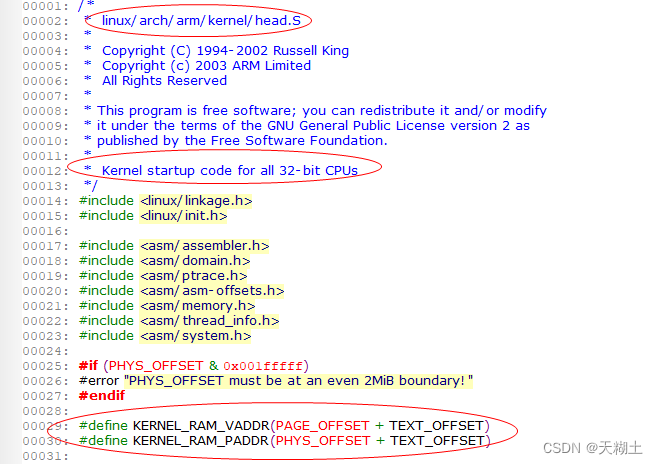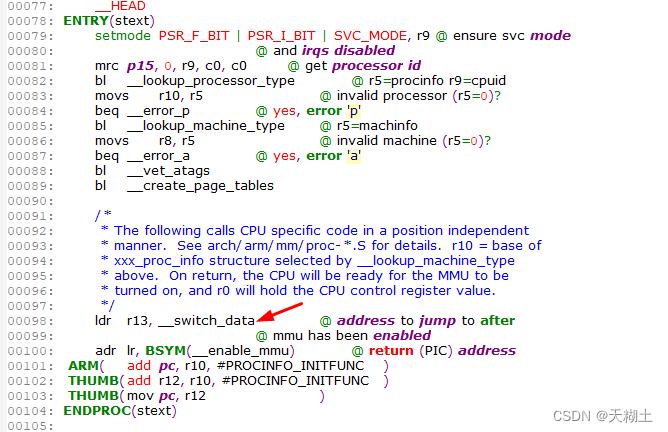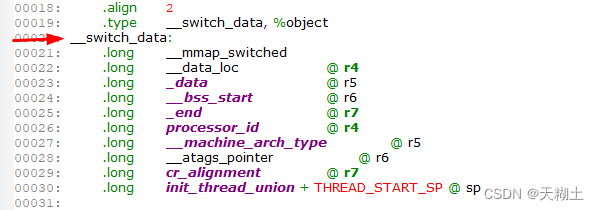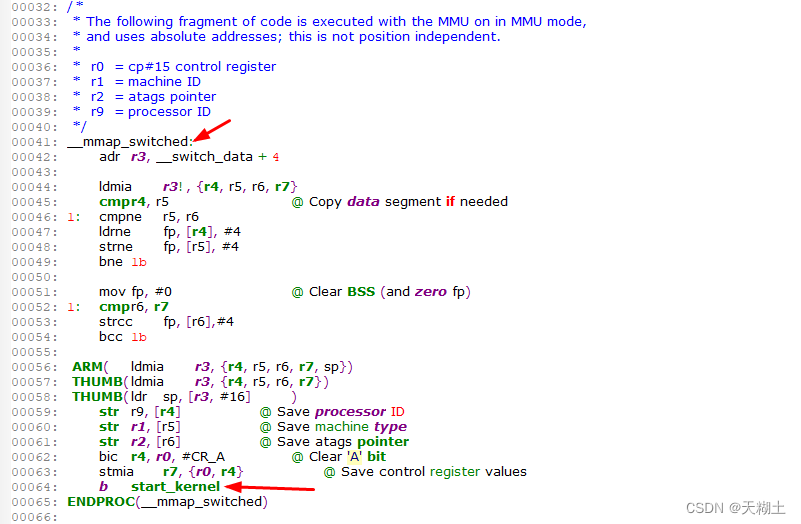以下内容源于朱有鹏嵌入式课程的学习,如有侵权,请告知删除。
前言
1、内容总结
汇编阶段,或者说内核引导阶段,主要是arch/arm/kernel/head.S文件,主要完成以下内容:
(1)校验启动合法性(CPU ID,机器码,uboot给内核的传参格式等)。
(2)建立段式映射的页表,并开启MMU以方便使用内存。
(3)构建C运行环境,跳入C阶段。
2、head.S文件代码
/** linux/arch/arm/kernel/head.S** Copyright (C) 1994-2002 Russell King* Copyright (c) 2003 ARM Limited* All Rights Reserved** This program is free software; you can redistribute it and/or modify* it under the terms of the GNU General Public License version 2 as* published by the Free Software Foundation.** Kernel startup code for all 32-bit CPUs*/ #include <linux/linkage.h> #include <linux/init.h>#include <asm/assembler.h> #include <asm/domain.h> #include <asm/ptrace.h> #include <asm/asm-offsets.h> #include <asm/memory.h> #include <asm/thread_info.h> #include <asm/system.h>#if (PHYS_OFFSET & 0x001fffff) #error "PHYS_OFFSET must be at an even 2MiB boundary!" #endif#define KERNEL_RAM_VADDR (PAGE_OFFSET + TEXT_OFFSET) #define KERNEL_RAM_PADDR (PHYS_OFFSET + TEXT_OFFSET)/** swapper_pg_dir is the virtual address of the initial page table.* We place the page tables 16K below KERNEL_RAM_VADDR. Therefore, we must* make sure that KERNEL_RAM_VADDR is correctly set. Currently, we expect* the least significant 16 bits to be 0x8000, but we could probably* relax this restriction to KERNEL_RAM_VADDR >= PAGE_OFFSET + 0x4000.*/ #if (KERNEL_RAM_VADDR & 0xffff) != 0x8000 #error KERNEL_RAM_VADDR must start at 0xXXXX8000 #endif.globl swapper_pg_dir.equ swapper_pg_dir, KERNEL_RAM_VADDR - 0x4000.macro pgtbl, rdldr \rd, =(KERNEL_RAM_PADDR - 0x4000).endm#ifdef CONFIG_XIP_KERNEL #define KERNEL_START XIP_VIRT_ADDR(CONFIG_XIP_PHYS_ADDR) #define KERNEL_END _edata_loc #else #define KERNEL_START KERNEL_RAM_VADDR #define KERNEL_END _end #endif/** Kernel startup entry point.* ---------------------------** This is normally called from the decompressor code. The requirements* are: MMU = off, D-cache = off, I-cache = dont care, r0 = 0,* r1 = machine nr, r2 = atags pointer.** This code is mostly position independent, so if you link the kernel at* 0xc0008000, you call this at __pa(0xc0008000).** See linux/arch/arm/tools/mach-types for the complete list of machine* numbers for r1.** We're trying to keep crap to a minimum; DO NOT add any machine specific* crap here - that's what the boot loader (or in extreme, well justified* circumstances, zImage) is for.*/__HEAD ENTRY(stext)setmode PSR_F_BIT | PSR_I_BIT | SVC_MODE, r9 @ ensure svc mode@ and irqs disabledmrc p15, 0, r9, c0, c0 @ get processor idbl __lookup_processor_type @ r5=procinfo r9=cpuidmovs r10, r5 @ invalid processor (r5=0)?beq __error_p @ yes, error 'p'bl __lookup_machine_type @ r5=machinfomovs r8, r5 @ invalid machine (r5=0)?beq __error_a @ yes, error 'a'bl __vet_atagsbl __create_page_tables/** The following calls CPU specific code in a position independent* manner. See arch/arm/mm/proc-*.S for details. r10 = base of* xxx_proc_info structure selected by __lookup_machine_type* above. On return, the CPU will be ready for the MMU to be* turned on, and r0 will hold the CPU control register value.*/ldr r13, __switch_data @ address to jump to after@ mmu has been enabledadr lr, BSYM(__enable_mmu) @ return (PIC) addressARM( add pc, r10, #PROCINFO_INITFUNC )THUMB( add r12, r10, #PROCINFO_INITFUNC )THUMB( mov pc, r12 ) ENDPROC(stext)#if defined(CONFIG_SMP) ENTRY(secondary_startup)/** Common entry point for secondary CPUs.** Ensure that we're in SVC mode, and IRQs are disabled. Lookup* the processor type - there is no need to check the machine type* as it has already been validated by the primary processor.*/setmode PSR_F_BIT | PSR_I_BIT | SVC_MODE, r9mrc p15, 0, r9, c0, c0 @ get processor idbl __lookup_processor_typemovs r10, r5 @ invalid processor?moveq r0, #'p' @ yes, error 'p'beq __error/** Use the page tables supplied from __cpu_up.*/adr r4, __secondary_dataldmia r4, {r5, r7, r12} @ address to jump to aftersub r4, r4, r5 @ mmu has been enabledldr r4, [r7, r4] @ get secondary_data.pgdiradr lr, BSYM(__enable_mmu) @ return addressmov r13, r12 @ __secondary_switched addressARM( add pc, r10, #PROCINFO_INITFUNC ) @ initialise processor@ (return control reg)THUMB( add r12, r10, #PROCINFO_INITFUNC )THUMB( mov pc, r12 ) ENDPROC(secondary_startup)/** r6 = &secondary_data*/ ENTRY(__secondary_switched)ldr sp, [r7, #4] @ get secondary_data.stackmov fp, #0b secondary_start_kernel ENDPROC(__secondary_switched).type __secondary_data, %object __secondary_data:.long ..long secondary_data.long __secondary_switched #endif /* defined(CONFIG_SMP) *//** Setup common bits before finally enabling the MMU. Essentially* this is just loading the page table pointer and domain access* registers.*/ __enable_mmu: #ifdef CONFIG_ALIGNMENT_TRAPorr r0, r0, #CR_A #elsebic r0, r0, #CR_A #endif #ifdef CONFIG_CPU_DCACHE_DISABLEbic r0, r0, #CR_C #endif #ifdef CONFIG_CPU_BPREDICT_DISABLEbic r0, r0, #CR_Z #endif #ifdef CONFIG_CPU_ICACHE_DISABLEbic r0, r0, #CR_I #endifmov r5, #(domain_val(DOMAIN_USER, DOMAIN_MANAGER) | \domain_val(DOMAIN_KERNEL, DOMAIN_MANAGER) | \domain_val(DOMAIN_TABLE, DOMAIN_MANAGER) | \domain_val(DOMAIN_IO, DOMAIN_CLIENT))mcr p15, 0, r5, c3, c0, 0 @ load domain access registermcr p15, 0, r4, c2, c0, 0 @ load page table pointerb __turn_mmu_on ENDPROC(__enable_mmu)/** Enable the MMU. This completely changes the structure of the visible* memory space. You will not be able to trace execution through this.* If you have an enquiry about this, *please* check the linux-arm-kernel* mailing list archives BEFORE sending another post to the list.** r0 = cp#15 control register* r13 = *virtual* address to jump to upon completion** other registers depend on the function called upon completion*/.align 5 __turn_mmu_on:mov r0, r0mcr p15, 0, r0, c1, c0, 0 @ write control regmrc p15, 0, r3, c0, c0, 0 @ read id regmov r3, r3mov r3, r13mov pc, r3 ENDPROC(__turn_mmu_on)/** Setup the initial page tables. We only setup the barest* amount which are required to get the kernel running, which* generally means mapping in the kernel code.** r8 = machinfo* r9 = cpuid* r10 = procinfo** Returns:* r0, r3, r6, r7 corrupted* r4 = physical page table address*/ __create_page_tables:pgtbl r4 @ page table address/** Clear the 16K level 1 swapper page table*/mov r0, r4mov r3, #0add r6, r0, #0x4000 1: str r3, [r0], #4str r3, [r0], #4str r3, [r0], #4str r3, [r0], #4teq r0, r6bne 1bldr r7, [r10, #PROCINFO_MM_MMUFLAGS] @ mm_mmuflags/** Create identity mapping for first MB of kernel to* cater for the MMU enable. This identity mapping* will be removed by paging_init(). We use our current program* counter to determine corresponding section base address.*/mov r6, pcmov r6, r6, lsr #20 @ start of kernel sectionorr r3, r7, r6, lsl #20 @ flags + kernel basestr r3, [r4, r6, lsl #2] @ identity mapping/** Now setup the pagetables for our kernel direct* mapped region.*/add r0, r4, #(KERNEL_START & 0xff000000) >> 18str r3, [r0, #(KERNEL_START & 0x00f00000) >> 18]!ldr r6, =(KERNEL_END - 1)add r0, r0, #4add r6, r4, r6, lsr #18 1: cmp r0, r6add r3, r3, #1 << 20strls r3, [r0], #4bls 1b#ifdef CONFIG_XIP_KERNEL/** Map some ram to cover our .data and .bss areas.*/orr r3, r7, #(KERNEL_RAM_PADDR & 0xff000000).if (KERNEL_RAM_PADDR & 0x00f00000)orr r3, r3, #(KERNEL_RAM_PADDR & 0x00f00000).endifadd r0, r4, #(KERNEL_RAM_VADDR & 0xff000000) >> 18str r3, [r0, #(KERNEL_RAM_VADDR & 0x00f00000) >> 18]!ldr r6, =(_end - 1)add r0, r0, #4add r6, r4, r6, lsr #18 1: cmp r0, r6add r3, r3, #1 << 20strls r3, [r0], #4bls 1b #endif/** Then map first 1MB of ram in case it contains our boot params.*/add r0, r4, #PAGE_OFFSET >> 18orr r6, r7, #(PHYS_OFFSET & 0xff000000).if (PHYS_OFFSET & 0x00f00000)orr r6, r6, #(PHYS_OFFSET & 0x00f00000).endifstr r6, [r0]#ifdef CONFIG_DEBUG_LLldr r7, [r10, #PROCINFO_IO_MMUFLAGS] @ io_mmuflags/** Map in IO space for serial debugging.* This allows debug messages to be output* via a serial console before paging_init.*/ldr r3, [r8, #MACHINFO_PGOFFIO]add r0, r4, r3rsb r3, r3, #0x4000 @ PTRS_PER_PGD*sizeof(long)cmp r3, #0x0800 @ limit to 512MBmovhi r3, #0x0800add r6, r0, r3ldr r3, [r8, #MACHINFO_PHYSIO]orr r3, r3, r7 1: str r3, [r0], #4add r3, r3, #1 << 20teq r0, r6bne 1b #if defined(CONFIG_ARCH_NETWINDER) || defined(CONFIG_ARCH_CATS)/** If we're using the NetWinder or CATS, we also need to map* in the 16550-type serial port for the debug messages*/add r0, r4, #0xff000000 >> 18orr r3, r7, #0x7c000000str r3, [r0] #endif #ifdef CONFIG_ARCH_RPC/** Map in screen at 0x02000000 & SCREEN2_BASE* Similar reasons here - for debug. This is* only for Acorn RiscPC architectures.*/add r0, r4, #0x02000000 >> 18orr r3, r7, #0x02000000str r3, [r0]add r0, r4, #0xd8000000 >> 18str r3, [r0] #endif #endifmov pc, lr ENDPROC(__create_page_tables).ltorg#include "head-common.S"
一、分析kernel的链接脚本
由内核配置与编译——内核的链接脚本可知,kernel的入口地址在arch/arm/kernel/head.S文件的ENTRY(stext)处。
二、分析head.S文件
1、内核运行的物理地址与虚拟地址
(1)KERNEL_RAM_VADDR(VADDR就是virtual address),这个宏定义了内核运行时的虚拟地址,值为0xC0008000。
(2)KERNEL_RAM_PADDR(PADDR就是physical address),这个宏定义内核运行时的物理地址,值为0x30008000。
(3)因此,内核运行的物理地址是0x30008000,对应的虚拟地址是0xC0008000。
2、内核的真正入口
(1)__HEAD定义了段名为.head.text的段。在/include/linux/init.h文件中,有如下代码:
/* For assembly routines */ #define __HEAD .section ".head.text","ax" //定义了段名为.head.text的段 #define __INIT .section ".init.text","ax" #define __FINIT .previous(2)“ENTRY(stext)”表明内核的真正入口。
(3)uboot启动内核后,实际调用zImage前面的那段未经压缩的解压代码,解压代码运行时先将zImage后面的部分解压开,然后再去调用运行真正的内核入口(即这里)。
(4)内核启动需要一定先决条件,这个条件由启动内核的bootloader(比如uboot)来构建保证。
(5)ARM体系中,函数调用时实际是通过寄存器传参的。
- 函数调用时传参有两种设计:一种是寄存器传参,另一种是栈内存传参。
- uboot中最后theKernel (0, machid, bd->bi_boot_params);执行内核时,实际把0放入r0中,machid放入到了r1中,bd->bi_boot_params放入到了r2中。
- ARM的这种处理技巧刚好满足了kernel启动的条件和要求。
(6)此时MMU是关闭的,因此硬件上需要的是物理地址。但是内核是一个整体(zImage)只能被链接到一个地址(不能分散加载),这个链接地址肯定是虚拟地址。因此head.S文件中尚未开启MMU之前的代码必须是位置无关码,而且其中涉及到操作硬件寄存器等时必须使用物理地址。
3、检验CPU_ID与机器码的合法性
分别通过__lookup_processor_type与__lookup_machine_type,校验CPU_ID与机器码的合法性。这两个函数都在arch/arm/kernel/head-common.S文件中。
__lookup_processor_type函数内容如下:
__lookup_machine_type函数内容如下:
(1)cp15协处理器的c0寄存器中读取出硬件的CPU ID号,然后调用__lookup_processor_type来进行合法性检验。如果合法则继续启动,如果不合法则停止启动,转向__error_p启动失败。
(2)__lookup_processor_type检验cpu id合法性的方法。内核会维护一个本内核支持的CPU ID号码的数组,然后该函数将从硬件中读取到的cpu id号码和数组中存储的各个id号码依次对比,如果没有一个相等则不合法,如果有一个相等的则合法。
(3)内核启动时设计这个校验,也是为了内核启动的安全性着想。
(4)__lookup_machine_type函数的设计理念和思路和上面校验cpu id的函数一样的,不同之处是本函数校验的是机器码。
4、校验uboot给内核传参的格式
利用__vet_atags函数,对uboot通过tag给内核传参的格式进行校验。
这函数在arch/arm/kernel/head-common.S文件中。
(1)该函数的设计思路和上面2个一样,用来对uboot通过tag给内核传参的格式进行校验。参数包括板子的内存分布memtag、uboot的bootargs等等。
(2)如果uboot给内核传参的格式不对,内核将启动不起来。比如uboot的bootargs设置不正确,则内核可能就会不启动。
5、建立段式页表
利用__create_page_tables函数建立段式页表。
这函数在arch/arm/kernel/head.S文件中。
(1)linux内核本身被链接在虚拟地址处,因此kernel希望尽快建立页表并且启动MMU进入虚拟地址工作状态。
(2)kernel建立页表分为2步。
- 第一步,先建立一个段式页表(1MB为单位的段页表)。段式页表建立过程简单(段式页表1MB一个映射,4GB空间需要4096个页表项,每个页表项4字节,因此一共需要16KB内存来做页表),但不能精细管理内存。上面的函数就是用来建立段式页表的。
- 第二步,然后建立一个细页表(4kb为单位的细页表),然后启用新的细页表,并废除第一步建立的段式映射页表。
(3)内核启动的早期建立段式页表,并在内核启动早期使用;内核启动的后期再次建立细页表并启用。等内核工作起来后,就只有细页表了。
6、构建C语言运行环境
(1)建立段式页表后进入__switch_data部分,它是一个函数指针数组。
(2)分析得知下一步要执行__mmap_switched函数。
- 复制数据段、清除bss段(目的是构建C语言运行环境)。
- 保存起来cpu id号、机器码、tag传参的首地址。
- b start_kernel跳转到C语言运行阶段。











)


改变数据透视表布局)
(转))


![SCOM Rule 介绍 [SCOM中文系列之六]](http://pic.xiahunao.cn/SCOM Rule 介绍 [SCOM中文系列之六])

--cocos2dx中的动画以及TexturePacker使用)



![All-In-One Code Framework [一站式示例代码库] 【转】](http://pic.xiahunao.cn/All-In-One Code Framework [一站式示例代码库] 【转】)




